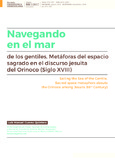Mostrar el registro sencillo del ítem
Navegando en el mar de los gentiles. Metáforas del espacio sagrado en el discurso jesuita del Orinoco (Siglo XVIII)
| dc.rights.license | http://creativecommons.org/licenses/by-nc-sa/3.0/ve/ | |
| dc.contributor.author | Cuevas Quintero, Luis Manuel | |
| dc.date.accessioned | 2017-10-03T22:18:06Z | |
| dc.date.available | 2017-10-03T22:18:06Z | |
| dc.date.issued | 2017-01 | |
| dc.identifier.uri | http://www.saber.ula.ve/handle/123456789/43821 | |
| dc.description.abstract | La multiplicidad del espacio geográfico se corresponde con la producción o construcción de campos de sentido a través de las operaciones geográficas de percepción, descripción, narración e interpretación. En cada operación, las imágenes se organizan a través de metáforas espaciales que orientan las relaciones del hombre con su entorno. La metáfora cumple aquí la función de entrecruzar al ambiente físico, las prácticas corporales y representaciones que envuelven las estrategias de apropiación o producción semántica del espacio. En sentido amplio, esta investigación se enfoca en el área geográfica del Orinoco. Pregunta por la función que toman ciertos documentos jesuitas, portadores en sí, de problemas vinculantes a la función metafórica dentro de la producción de la imaginación geográfica en los trópicos y la organización de un campo espacial ligado a lo sagrado. | es_VE |
| dc.language.iso | es | es_VE |
| dc.rights | info:eu-repo/semantics/openAccess | |
| dc.subject | Geografía cultural | es_VE |
| dc.subject | Metáfora | es_VE |
| dc.subject | Orinoco | es_VE |
| dc.subject | Jesuitas | es_VE |
| dc.subject | Imaginación geográfica | es_VE |
| dc.title | Navegando en el mar de los gentiles. Metáforas del espacio sagrado en el discurso jesuita del Orinoco (Siglo XVIII) | es_VE |
| dc.title.alternative | Sailing the Sea of the Gentile. Sacred space metaphors abouts the Orinoco among Jesuits (18th Century) | es_VE |
| dc.type | info:eu-repo/semantics/article | |
| dc.description.abstract1 | The multiplicity of geographical space corresponds to the production or construction of sense fields through geographical operations of perception, description, narration, and interpretation. In each of the abovementioned operations, the images are organized through spatial metaphors that guide the relationship between man and his environment. The metaphor fulfils a function of crosslink the physical environment, corporal practices and representations involving strategies of appropriation or semantic production of space. In a broad sense, this research focuses on the geographic area of the Orinoco. It also enquiries about the function of certain documents written by Jesuit missionaries which portrayed some problems concerning metaphors involving the production processes of the geographical imagination in the tropics and the organization of a sense field of space linked to the sacred. | es_VE |
| dc.description.colacion | 222-239 | es_VE |
| dc.description.email | luimanc@yahoo.com | es_VE |
| dc.description.frecuencia | Semestral | |
| dc.identifier.edepositolegal | ppi 2012ME4104 | |
| dc.identifier.eissn | 2244-8853 | |
| dc.publisher.pais | Venezuela | es_VE |
| dc.subject.facultad | Facultad de Ciencias Forestales y Ambientales | es_VE |
| dc.subject.institutoinvestigacion | Instituto de Geografía y Conservación de los Recursos Naturales (IGCRN) | |
| dc.subject.keywords | Cultural geography | es_VE |
| dc.subject.keywords | Metaphor | es_VE |
| dc.subject.keywords | Orinoco | es_VE |
| dc.subject.keywords | Jesuits | es_VE |
| dc.subject.keywords | Geographical imagination. | es_VE |
| dc.subject.thematiccategory | Geografía | es_VE |
| dc.subject.tipo | Revistas | es_VE |
| dc.type.media | Texto | es_VE |
Ficheros en el ítem
Este ítem aparece en la(s) siguiente(s) colección(ones)
-
Revista Geográfica Venezolana - 058(1)
Enero - Junio 2017


